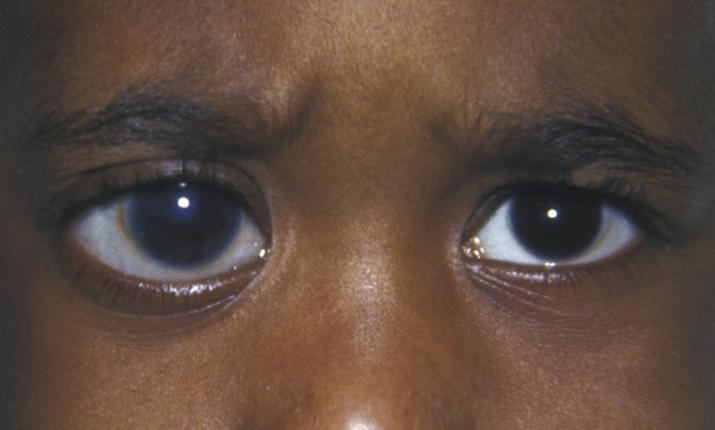(See Figure 8.11.1.)
Critical
Enlarged globe and corneal diameter (horizontal corneal diameter >12 mm before 1 year of age is suggestive), corneal edema, Haab striae (curvilinear tears in Descemet membrane of the cornea, with scalloped edges with or without associated stromal haze), increased cup/disc ratio, high intraocular pressure (IOP), axial myopia, commonly bilateral (80%). Classic findings are tearing, photophobia, blepharospasm, corneal clouding, and a large eye (buphthalmos).
Other
Corneal stromal scarring or opacification; high iris insertion on gonioscopy; other signs of iris dysgenesis, including heterochromia, may exist.
8-11.1 Buphthalmos of right eye in congenital glaucoma.

Definitive treatment is surgical, particularly in primary congenital glaucoma. Medical therapy is utilized as a temporizing measure before surgery and to help clear the cornea in preparation for possible goniotomy.
- Medical:
- Oral carbonic anhydrase inhibitor (e.g., acetazolamide, 15 to 30 mg/kg/d in three or four divided doses): Most effective.
- Topical carbonic anhydrase inhibitor (e.g., dorzolamide or brinzolamide b.i.d.): Less effective; better tolerated.
- Topical beta-blocker (e.g., levobunolol or timolol, 0.25% if <1 year old or 0.5% if older b.i.d.): Important to avoid in asthma patients (betaxolol preferable).
- Prostaglandin analogs (e.g., latanoprost q.h.s.).
- Surgical: Nasal goniotomy (incising the trabecular meshwork with a blade or needle under gonioscopic visualization) is the procedure of choice, although some surgeons initially recommend trabeculotomy. Miotics are sometimes used to constrict the pupil before a surgical goniotomy. If the cornea is not clear, trabeculotomy (opening the Schlemm canal from a scleral approach ab externo into the anterior chamber) or endoscopic goniotomy can be performed. If the initial goniotomy is unsuccessful, a temporal goniotomy may be tried. Trabeculectomy or tube shunt may be performed following failed angle incision operations. Cyclodestruction of the ciliary processes through cyclophotocoagulation or cryotherapy may also be an option to decrease aqueous production in certain circumstances.
 NOTE: NOTE: |
Brimonidine is contraindicated in children under the age of 1 year because of the risk of apnea/hypotension/bradycardia/hypothermia from blood–brain permeability. Caution should be used in children under 5 years old or <20 kg or intracranial pathology (such as Sturge–Weber syndrome). |
 NOTE: NOTE: |
Amblyopia is the most common cause of visual loss in pediatric glaucoma and should be treated appropriately. See 8.7, AMBLYOPIA. |
